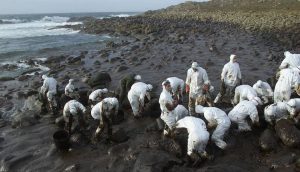
©Uly Martín.
En unas semanas, se cumplirán 20 años de un fenómeno que marcó un hito ambiental. El 13 de noviembre de 2002, el buque monocasco Prestige, que portaba 77000 toneladas de petróleo pidió socorro a unos 50 km de Finisterre (costa gallega). El buque presentaba una brecha en el lado estribor del casco que provocó el hundimiento del barco y la mayor catástrofe ecológica de España.
Después de varios días de maniobras para el alejamiento de la costa gallega, el buque acabó partiéndose en dos y hundiéndose a 250 km de la costa.
Miles de toneladas de chapapote llegaron, no sólo a las costas gallegas, sino que se extendieron por la costa cantábrica y el sur de Francia, provocando una de las mayores mareas negras de la historia. El fuel batió contra los acantilados de la Costa da Morte, las Islas Cíes y Ons, consideradas playas de alto valor natural y paisajístico.
La tripulación fue rápidamente evacuada en el momento del accidente. Inmediatamente a la fractura, del buque salieron 5000 toneladas de fuel. La estrategia llevada a cabo de basaba en remolcar el barco lo más lejos posible de la costa. El sistema de remolques estaba formado por el Deda (remolque contratado por la empresa holandesa que se hizo cargo del buque), un remolcador Ría de Vigo y otro llamado Alonso de Chaves. Además, participaron buques de la Armada portuguesa y la Fragata Baleares. El viernes 15 (dos días después del accidente) se decidió apagar los motores, ya que las vibraciones aumentaban la grieta lateral, que a las 20:00h de ese mismo día ya era de 35 m. El lunes 18 de noviembre, el barco fue arrastrado por un remolcador chino y controlado por dos remolcadores españoles y una fragata. Finalmente, el martes 19, el petrolero se partió en dos y acabó hundiéndose.
A nivel jurídico, la Ley de 41/2010, del 29 de diciembre de protección del medio marino contiene en el Titulo IV “De los vertidos de desechos u otras materias desde buques, aeronaves, plataformas u otras construcciones en el mar”. En esta parte, se define el concepto de vertido y se marcan estrategias de protección frente a catástrofes como la acontecida en 2002.
Este fenómeno marcó un triste hito en la historia ecológica de España. Sin embargo, fue evidente la ayuda internacional y de numerosos voluntarios que se volcaron para salvar las costas y toda la flora y fauna que sufrió las consecuencias de esta catástrofe.
__
20 YEARS OF THE GREAT OIL SLICK
In a few weeks, it will be 20 years since an environmental milestone. On November 13th, 2002, the single-hulled ship Prestige, carrying 77,000 tons of oil, called for help some 50 km off Finisterre (Galician coast). The vessel had a breach on the starboard side of the hull, which caused the sinking of the ship and the biggest ecological disaster in Spain.
After several days of maneuvering away from the Galician coast, the ship finally broke in two and sank 250 km from the coast.
Thousands of tons of chapapote not only reached the Galician coast, but also spread along the Cantabrian coast and the south of France, causing one of the biggest oil spills in history. The fuel oil hit the cliffs of the Costa da Morte, the Cíes and Ons Islands, considered beaches of high natural and scenic value.
The crew was quickly evacuated at the time of the accident. Immediately after the fracture, 5,000 tons of fuel oil were released from the vessel. The strategy was to tow the ship as far away from the coast as possible. The towing system consisted of the Deda (a tug hired by the Dutch company that took over the ship), a tug Ría de Vigo and another one called Alonso de Chaves. In addition, vessels from the Portuguese Navy and the Fragata Baleares also participated. On Friday 15th (two days after the accident) it was decided to shut down the engines, as the vibrations were increasing the lateral crack, which at 20:00h of that same day was already 35 m. On Monday, November 18th, the ship was towed by a Chinese tug and controlled by two Spanish tugs and a frigate. Finally, on Tuesday, November 19th, the tanker broke in two and sank.
At the legal level, the Law 41/2010, of December 29th, 2010 on the protection of the marine environment contains in Title IV “On the dumping of waste or other materials from ships, aircraft, platforms or other constructions at sea”. In this part, the concept of spill is defined and protection strategies are established in the face of catastrophes such as the one that occurred in 2002.
This phenomenon marked a sad milestone in Spain’s ecological history. However, it was evident the international help and the numerous volunteers who turned out to save the coasts and all the flora and fauna that suffered the consequences of this catastrophe.
__

